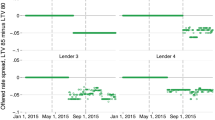Abstract
Public policy concerns increasingly have focused on subprime lending. Our research uses a survey of prime and subprime borrowers to address whether borrowers “inappropriately” are channeled to the subprime segment, if once having taken out a subprime mortgage borrowers are “stuck” in this market segment, and whether borrowers face higher costs by taking out subprime mortgages. We find that subprime borrowers are less knowledgeable about the mortgage process, are less likely to search for the best mortgage rates, and are less likely to be offered a choice among alternative mortgage terms and instruments—possibly making them more vulnerable to unfavorable mortgage outcomes. Our analysis of market segmentation confirms that typical mortgage underwriting criteria are most important in explaining whether borrowers obtain prime or subprime mortgages—higher credit risk borrowers are more likely to get a subprime loan. Our results further show that search behavior and other demographic factors including adverse life events, age, and Hispanic ethnicity contribute to explaining market segment, suggesting that borrowers may inappropriately receive subprime mortgages. While we find some persistence to market segment—borrowers are more likely to take out a subprime mortgage if their previous mortgage came from the subprime segment—we also find that market segment is not immutable. Analysis of the survey responses indicates that borrowers with subprime mortgages significantly are more dissatisfied with their mortgage outcomes. This is not surprising because subprime borrowers look worse across typical mortgage underwriting criteria. Consistent with policy concerns, however, despite holding constant these and other factors, taking out a mortgage in the subprime segment, by itself, appears to increase dissatisfaction with mortgage outcomes. We do not provide a definitive answer to the question of whether subprime lending, on balance, serves homebuyers well by providing access to mortgage credit to those otherwise constrained, or rather serves homebuyers poorly by inappropriately assigning them to a market where costs are high and the ability to transition to more attractive prime mortgages remains low. Our analysis, however, does provide some empirical support for concerns raised by critics of subprime lending, and for this reason justifies continued public policy debate and analysis.
Similar content being viewed by others
References
AARP Public Policy Institute. (2002). “Older Subprime Refinance Mortgage Borrowers,” Data Digest 74.
Bradford, C. (2002). “Risk or Race? Racial Disparities and the Subprime Mortgage Market,” Report Issued by the Center for Community Change.
Brueckner, J. (1994). “The Demand for Mortgage Debt: Some Basic Results,” Journal of Housing Economics 3, 251-262.
Calem, P., and S. M. Wachter. (1999). “Performance of Mortgages in a Community Reinvestment Portfolio,” Real Estate Economics 28(3), 385-404.
Canner, G., W. Passmore, and E. Laderman. (1999). “The Role of Specialized Lenders in Extending Mortgages to Lower-Income and Minority Borrowers,” Federal Reserve Bulletin 85(11), 709-726.
Harvey, K., and P. Nigro. (2004). “Do Predatory Lending Laws Influence Mortgage Lending? An Analysis of the North Carolina Predatory Lending Law,” Journal or Real Estate Finance and Economics 29(4), 435-456.
Inside Mortgage Finance. (2002). Inside B&C Lending 7(16), 08/12/2002, 3.
Jones, L. (1993). “The Demand for Home Mortgage Debt,” Journal of Urban Economics 33, 10-28.
Lax, H., M. Manti, P. Raca, and P. Zorn. (2004). “Subprime Lending: An Investigation of Economic Efficiency,” forthcoming, Housing Policy Debate.
Phillips, R., and A. Yezer. (1996). “Self-Selection and Tests for Bias and Risk in Mortgage Lending: Can You Price the Mortgage If You Don't Know the Process?” Journal of Real Estate Research 11(1), 87-102.
Rachlis, M., and A. Yezer. (1993). “Serious Flaws for Statistical Tests for Discrimination in Mortgage Markets,” Journal of Housing Research 4(2), 315-336.
Staten, M., and G. Elliehausen. (2001). “The Impact of the Federal Reserve Board's Proposed Revisions to HOEPA on the Number and Characteristics of HOEPA Loans,” Report prepared by the Credit Research Center.
Weicher, J. (1997). “The Home Equity Lending Industry: Refinancing Mortgages for Borrowers with Impaired Credit,” Hudson Institute: Indianapolis.
Rights and permissions
About this article
Cite this article
Courchane, M.J., Surette, B.J. & Zorn, P.M. Subprime Borrowers: Mortgage Transitions and Outcomes. The Journal of Real Estate Finance and Economics 29, 365–392 (2004). https://doi.org/10.1023/B:REAL.0000044019.57580.18
Issue Date:
DOI: https://doi.org/10.1023/B:REAL.0000044019.57580.18




